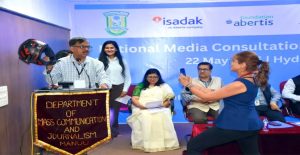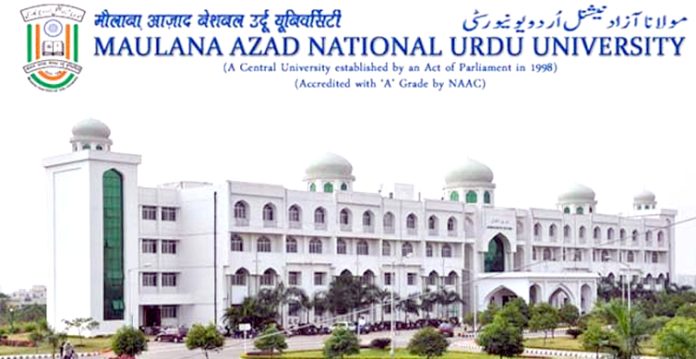Creating safer roads for children and young people requires strong partnerships between government, educators and communities in partnership with the media. This was the key message echoed at the National Media Consultation on Road Safety and Systems Strengthening, organized by UNICEF India today in collaboration with the Department of Mass Communication and Journalism, Maulana Azad National Urdu University (MANUU).
The day-long dialogue focused on repositioning road safety as a critical child rights, public health, and development issue—and on strengthening the role of media in influencing safer behaviour, better enforcement, and systemic reform.

Professor Mohammad Fariyad, Dean and Head, School of Journalism and Mass Communication, warmly welcomed the esteemed guests from UNICEF, media persons including radio RJs from various cities including Hyderabad, Bengaluru, Chennai, and Kochi, acknowledging their vital role in using media as a tool for advocacy and behavioural change. He emphasized the power of community radio and youth-driven campaigns in spreading awareness about road safety and fostering responsible road behaviour, particularly among children and adolescents.
Also Read: MANUU to Expand Campus and Introduce New Courses for Women at Urdu Hall
Opening the event, Ms. Zafrin Chowdhury, Chief of Communication, Advocacy and Partnerships at UNICEF India, emphasized the role of media in shaping public perception and accountability. “Children’s safety on the roads requires more than laws and infrastructure—it demands collaborative, collective action. Safer school zones, stronger emergency care systems, and awareness campaigns all play a role. Media holds a unique power: turning statistics into compelling stories, and stories that encourage individual and societal action. Journalists, RJs, and storytellers can lead a movement for change,” she said.
The consultation brought together over 100 participants, including MANUU faculty and students, nearly 50 Radio Jockeys and producers, media professionals from print and television, government officials, civil society representatives, and youth advocates.
The consultation comes at a time when India is facing a concerning rise in road fatalities among its youngest citizens. In 2022 alone, more than 16,443 children and adolescents under 18 died in road crashes—making it the leading cause of death in the 5–19 age group. A vast majority of these deaths involve vulnerable road users—cyclists, pedestrians, and two-wheeler riders—many of whom were not wearing helmets. Media coverage however remains largely confined to major incidents or high-profile cases, leaving tragedies and systemic issues underreported.
Mr. P Shiv Shankar, cheif general manager regional office NHAI Hyderabad reinforced the commitment of NHAI for making roads safer particularly for vulnerable road users i.e padetrians, cyclist and motorcyclist apart from all the vehicles plying on national highways. He stressed upon the importance of education, enforcement, evidence and, engineering as multidintions that should be considered togather for making roads safer.
Prof. Syed Ainul Hasan, Hon’ble Vice Chancellor of MANUU, underlined the university’s role in preparing journalists who think deeper and contribute to positive shift. “This consultation is not just a workshop. It is a call to conscience. Our students are being trained to be sensitive communicators who report with depth and responsibility. Road safety is a powerful lens to connect infrastructure, equity, and justice—and that’s the kind of journalism we must nurture,” he said.
Mr. Ramon Chesa, Chief Executive Officer of ISADAK – An Abertis Company, reinforced the importance of cross-sector collaboration. “Children must be at the heart of all road safety strategies. Whether it’s school zone speed regulation or helmet laws, our focus must remain on the most vulnerable. That’s why partnerships with universities, media and global institutions like UNICEF are crucial,” he stated.
Dr Zelalem Taffesse, Chief Field Office Hyderabad, UNICEF, highlighted the urgent need for a multi-sectorial approach for road safety. “We need all stakeholders to come together including National and State Governments, local government, City corporations, education departments and schools, highway authorities, health departments, hospitals (public and private), radio jockeys, print and TV to ensure road safety.
Trauma response is a major gap. Many children die at the crash site. We need integrated systems that include paediatric emergency care, trained responders, and awareness at the community level. Health systems must become part of the road safety conversation,” he said.
Dr. Syed Hubbe Ali, Health Specialist, UNICEF India Country Office, highlighted the need for an integrated public health response to road safety, especially one centred on prevention. “Road crashes are not only a transportation issue—they are a major but under-recognised health burden. We must strengthen trauma care systems, empower communities with first-response knowledge, and ensure child safety is at the heart of all mobility planning,” he said.
Dr Ali highlighted that over 10 rounds of technical consultations, road map on Road Safety focusing on adolescents and children was released jointly by the Ministry of Road Transport and Highways and Ministry of Health in the recently held World Health Summit hosted by India in April 2025.
A high-level panel discussion on “The Role of Media in Road Safety for Children and Youth” was a key feature of the day. Moderated by senior journalist Srinjoy Chowdhury the panel included representatives from media, schools and public health. Dr G Gururaj, Head, WHO Collaborating Centre on Road Safety and Injury Prevention, Bangalore, noted that road crashes are not random accidents but predictable outcomes of systemic failures.
“We have the data. We have the laws. What we lack is sustained discourse and public demand—and that is where media must step in. Telling the right stories can prevent the wrong outcomes,” he remarked.
Other delegates participated in the consultation were Dr. G Gururaj from WHO collabolating centre NIMHANS, Dr. Sridhar Ryavanki, health Specialist UNICEF, Hyderabad field office, Telangana, Karnataka, Andhra Pradesh and Ms. Rachna Sharma, Principal of Silver Oaks International School, Hyderabad. The consultation included an address by youth advocate Shyam Shukla, who spoke about the importance of helmet use and youth responsibility.
Radio participants co-created radio content through group work, facilitated by Sonia Sarkar and Prosun Sen from UNICEF as well as teachers from MANUU. Contents range from public service announcements and jingles to youth-focused talk shows and interactive RJ segments. These audio products, addressed themes like helmet usage, school commute safety, juvenile driving risks, and bystander response.
The event concluded with a collective call to action for media houses, universities, and policy actors to integrate road safety as a development priority—not merely a traffic issue. Participants pledged to amplify child safety narratives and strengthen behaviour change communication through community-rooted formats, especially in underserved areas where the risks are highest.
(This story is sourced from a third-party syndicated feed. Raavi Media takes no responsibility or liability of any nature. Raavi Media management/ythisnews.com can alter or delete the content without notice for any reason.)


